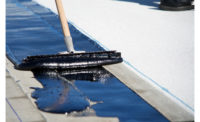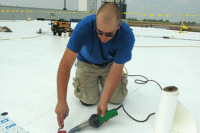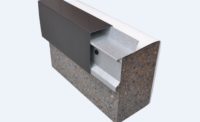
Low-slope roofing systems are defined by code as roof systems applied on slopes of 2:12 or less. It is the architect or designer’s responsibility to specify the system that is best suited for the facility. There are three basic types of conventional roofing systems used in commercial construction. We examined built-up roof systems and modified bitumen systems in Volume 3 (See “Low-Slope Roofing Systems Part 1”). This article focuses on single-ply roof systems.
There are two main groups of single-ply roof systems. They are thermosets (mainly comprised of EPDM) and thermoplastics (comprised of several polymer formulations).
EPDM Roof Systems
EPDM systems have been on the United States low-slope roofing market since the 1960s. Their widespread use began in the 1980s and the technology has developed a favorable market share in the industry since that time. The rise in market share correlated with the United States Energy Crisis of the 1970s, which drove up the price of bitumen. During the development boom of the 1980s, roofing labor shortages helped drive the market.
The size of the membrane sheets (typically 20 feet by 100 feet) allowed contractors to install the systems with less manpower and virtually no equipment. These factors quickly contributed to the widespread acceptance of EPDM systems, as they were more economical to install over the labor-intensive, equipmentladen built-up roof systems.
Contractors also found a willing workforce who did not have to contend with the safety risks and odors associated with hot bitumen. Instead of long pants, long shirts and heavy work boots, EPDM applicators could comfortably work in short sleeve shirts, short pants and tennis shoes. Building owners and developers quickly gravitated to the initial cost savings provided by these systems. EPDM is synthesized from ethylene, propylene and small amounts of diene monomer, and these ingredients give the material its name.
The basic rubber polymer (EPDM) is the binder of the sheets and constitutes 50 percent of the total formulation. The formulation also consists of carbon black, antiozonants, antioxidants and other curing agents that account for another 25 percent of the formulation including oils, which act as plasticizers and rubber extenders. The mixed rubber is called a rubber compound.
Carbon black is added to the EPDM polymer to add structure to the composition. Carbon black is the byproduct of oil or natural gas that has combusted under the deficient supply of oxygen. Carbon black adds the reinforcement to the sheet and also adds the color to the membrane. The proper amount of carbon black can double or triple a sheet’s tensile strength.
Oils are added to improve the low temperature flexibility of the rubber materials. Typically, the structure of the carbon black and other reinforc- ing materials make it difficult to blend into the EPDM composition. Oils are added to allow for quicker mixing and to keep the sheet in a flexible condition. The oils used are generally long chain paraffinic oils that are very temperature stable. This helps the EPDM withstand rooftop temperatures from 40 below zero to 180 degrees without losing flexibility.
EPDM sheets are manufactured in widths from 54 inches to 50 feet and in lengths of 50 feet to 200 feet. The standard thicknesses of EPDM are 45 mils (0.045 inch) and 60 mils (0.060 inch). Some manufacturers provide sheets with thicknesses of 75 to 100 mils. Most EPDM sheets are reinforced.

Application Methods
Whereas built-up roof systems and modified bitumen systems are generally applied in a similar manner not withstanding the bituminous product - asphalt or coal tar, adhesive, torch, self-adhered - single-ply roofs are installed in one of three separate application methods. There are three types of application systems for EPDM membrane. They are:
• Loose-laid ballasted.
• Mechanically attached.
• Fully adhered.
Although the repair procedures to the membrane remain consistent, inspection for maintenance purposes and problems may differ with each application method.
Loose-Laid Ballasted
This is the least expensive of all roof applications. The premise is simple. As the name implies, insulation is set over the roof deck in a loose manner. A single layer of EPDM is set over the insulation. The membrane is only adhered at the seams, flashings, and penetrations. Ballast is applied over the membrane to serve as weight for the roof system. It should be noted that Factory Mutual does not recognize this method of application as a proper roof system due to the potential for roof blow offs. Due to the ballast application, inspection of the membrane and locating roof leaks is very difficult and time consuming.
Mechanically Attached
With mechanically attached systems, the EPDM is secured at strips or using the point method. The strip attachment method uses linear bars hidden at each membrane lap with fasteners penetrating the membrane and insulation into the deck. The point method uses stress plates and metal fasteners or wide plates that are fastened to the deck. The EPDM membrane is adhered to the plates.
Fully Adhered
With a fully adhered system, EPDM membrane is adhered to the substrate (deck or insulation) with cold adhesive or contact cement. The full underside of the membrane sheet must be adhered for proper attachment.
Thermoplastic Roof Systems
There are currently six thermoplastic single-ply roof membranes used in the United States. They are:
• Copolymer alloys (CPA).
• Chlorosulfonated polyethylene or Hypalon (CSPE).
• Ethylene interpolymer alloy (EIP).
• Nitrile thermoplastic membrane (NBP).
• Polyvinyl Chloride (PVC).
• Thermoplastic polyolefins (TPO).
Copolymer Alloys
Copolymer alloy (CPA) thermoplastics are often referred to as modified PVCs in reference to the material’s PVC base content. The membrane sheets are plasticized vinyl with base resins that are primarily made of PVC and other blends of polymers.
The applied plasticizers are used to keep the materials in a flexible state. The average elongation of the material is 25 percent to 40 percent. All CPA membrane sheets are reinforced with polyester.
Due to the chlorine content from the PVC formulation, the membrane has inherent fire resistance. However, all of the manufacturers of these membranes add additional fire retardants. Similar to PVC membranes, the chlorine component is considered an environmental hazard. Because chlorine is not an environmentally friendly chemical, future disposal may be complicated.
In the manufacturing process, the formulated polymer is applied to both sides of the non-woven polyester fabric. The membrane is then run through a laminating machine and is formed into a composite sheet. One manufacturer of CPA prefabricates up to 85 percent of the membrane in a manufacturing facility and delivers a completed membrane, with fully adhered seams, to the building site. In this process all seams are adhered in a controlled environment free of dirt, dust, wind and precipitation.
CPA membranes have been on the United States roofing market for over 20 years, which is a sufficient track record to investigate their performance capabilities. They generally have a greater chemical resistance than standard PVCs and EPDMs.
Chlorosulfonated Polyethylene
Chlorosulfonated polyethylene (CSPE) membranes commonly referred to as Hypalon, utilize a synthetic rubber membrane that has been on the United States roofing market for well over 20 years. CSPE is a synthetic rubber that is formulated around prime polymers that are assisted by a blend of pigments and fillers. The main polymer is chlorinated polyethylene (CPE) blended with an occasional chlorosulphonyl group instead of chlorine. The chlorosulphonyl groups are crosslinked into the polyethylene molecules of the adjacent chains, which form a more rigid thermalset structure after curing. The other ingredients include, but are not limited to, CaCO (filler), TiO (for whitening and UV resistance), MgO (for cross linking and color stabilizing), processing aids, antistat and antioxidant compounds, and epoxy based curing agents.
CSPE is classified as a non-vulcanized elastomeric because the material has rubber-like characteristics. These membranes have the capacity to stretch under stress and return to their original state once the stress is removed. The nonvulcanized membrane is processed in an uncured state, curing begins once the material is exposed to the elements of sunlight, heat or moisture. The vulcanization process occurs when the molecular structure becomes permanently fixed. Once the material has cured all seams must be completed using an adhesive. Due to this fact, it is advisable that all flashing work and seams are completed the same day. This type of adhesion method is inferior to heat welding and may not provide proper long-term waterproofing performance. Prior to curing, seams can be completed using a solvent or by hot air welding.
CSPE sheets are manufactured through a calendering process by applying the formulated polymer to a reinforcement sheet. For mechanically fastened systems, the reinforcement sheet is typically a polyester mat. Mineral fiber or felt backing sheets are typically used for fully adhered and ballasted systems.
The fully adhered sheets can be attached to the substrate with either latex adhesive or modified asphalt. Membranes are available in thicknesses of 30 to 60 mils.
One of the primary advantages of these membranes is their ability to accommodate thermal movement and mechanical strains. This is due to the high elasticity of the sheet propagated from the materials conversion from a plastic in an uncured state to an elastomer in the cured state. This change provides the cross-linked material with substantial creep resistance.
The membrane has also exhibited high resistance to ultraviolet radiation and most of the atmospheric pollutants. The membrane surface is self-cleaning through continuous exposure to ultraviolet radiation. It has also proved to be a preferable product for restaurants and food processing facilities because it has superior resistance to grease, mineral fats and oils.
There have been reported problems associated with these membranes. One significant concern is the excess chalking of the membrane surface. This phenomenon predominately occurs when the pigment in the sheet washes away from the surfacing. If the loss of the pigment manifests itself as surface erosion and there is an eventual decrease of mil thickness, this can shorten the performance service life of the system. Another concern associated with these membranes is associated with algae and biological agents. These problems have mainly been reported in warm, humid climates and costal areas. The membrane is also prone to degradation by accelerated weathering.
Symptoms such as surface checking and cracking down to the reinforcement scrim occur when there are physical and chemical changes caused by UV radiation, heat, and water and thermal shock.
It should be pointed out that these failures are primarily caused by formulation problems by individual manufacturers. There is no evidence of inherent polymer failures. In most cases, these issues can be resolved by modifying the formulation through the use of pigments, biocides, and other accepted ingredients. However, it is known that CSPE is adversely affected by chlorinated and halogenated hydrocarbons. The service life of these membranes can be extended with a top surfacing of 100 percent acrylic elastomeric coatings.

Ethylene Interpolymer Alloy
Ethylene Interpolymer Alloy (EIP) is a combination of polyvinyl chloride (PVC) and keytone ethylene ester (KEE). The modifier for the KEE polymer is a polymeric plasticizer, which is less susceptible to plasticizer migration and generally more chemical resistant than the monomeric plasticizers that are used in PVC membranes.
However, monomeric plasticizers do provide lower water absorption characteristics and greater flexibility at lower ambient temperatures than polymeric plasticizers. EIP membranes are reinforced with a variety of polyester fabrics that have a proprietary weave design. The membranes are available in standard mil thicknesses of 45 to 60 mils.
They are designed for use in mechanically fastened or fully adhered applications. Some manufacturers offer fleecebacked sheets that can be fully adhered to asphalt based systems using asphalt adhesives. These membranes are manufactured by applying the formulated polymer over the weft-reinforced polyester prior to the production of the sheet. This produces a monolithic sheet and reduces the potential of membrane wicking and delamination. A patented process that impregnates the fibers to the reinforcement sheet is applied that helps in the formation of a molecular bond.
The membrane sheets are produced in varying lengths to reduce the number of seams that require on-site hot air welding, which cuts labor costs. The reinforcement of the membrane provides substantial puncture resistance, durability and dimensional stability. EIP membranes also offer exceptional resistance to degradation from ultraviolet radiation, fire, ozone and chemical exposure.
Nitrile Thermoplastic Membrane
Nitrile thermoplastic membrane (NBP), or nitrile alloy with butadiene acrylonitrile copolymers, is formulated from a blend similar to CPA membranes; however, it substitutes nitrile rubber in place of plasticizers. The nitrile rubber provides the NRP membrane with greater flexibility and better chemical resistance than a straight PVC membrane. There are as many as 18 other polymers used in the formulation that contribute to the membrane’s performance.
Polyvinyl Chloride
The Polyvinyl chloride (PVC) membranes currently produced have advanced from the early formulations.
There are four basic ingredients in the current PVC membranes: PVC resin. Plasticizers, stabilizers and pigments. For proper performance all four of these ingredients must be properly balanced. The plasticizers that are currently applied are significantly better than the initial type, resulting in less plasticizer loss from the membrane.
The manufacturers have recognized that a thin sheet loses more plasticizer than a thicker one. That is primarily why they have increased the mil thickness of the sheets above the initial 32 mils. There are no current PVC membranes on the United States market that are less than the minimum allowed by ASTM D4434 for PVC membranes, which is 36 mils. Furthermore, the addition of reinforcements (polyester or fiberglass) to all membrane sheets has significantly reduced PVC shattering.
Thermoplastic Olefin
Thermoplastic olefin sheets are produced using polypropylene (PP) or polyethylene (PE) polymers.
Most membranes supplied in the United States use polypropylene. In polypropylene-based membranes the polymer is blended with thermoset polymers (elastomeric polymers of EPR) to produce a sheet with characteristics of high flexibility and mechanical strength. The polypropylene based materials are typically stiff or rigid sheets. The raw materials consist of reactor polymers. A typical formulation for polypropylene based thermoplastic olefins is approximately 70 percent ethylene-propylene rubber and approximately 30 percent polypropylene.
The main advantage of these systems is that they have the inherent flexibility provided by the thermoset polymers and the seams are heat welded due to the thermoplastic polymers.
Polyethylene-based materials consist of special grades of copolymers and terpolymers of polyethylene that are blended together to form a highly flexible polymer alloy. The terpolymers consist of acetates, acrylates, or octene. The flexibility of the sheets allows for easier contractor handling.
Chemical Resistance
Thermoplastic olefins have inherent chemical resistance properties and can endure most animal fats, vegetable oils, microbial attack and some acids. They are inorganic materials that do not contain oils or compounds that would support biological growth, lowering the possibility of algae or fungus growth. The material contains more than twice the polymer and less than half the filler of EPDM, which makes it chemically resistant to the same types of materials as EPDM. The low filler content ensures very low water transmission and enhances long-term performance. TPOs do not have the same chemical resistance abilities as CSPE and some PVCs.
The standard thicknesses for the sheets on the United States market are 0.045 inches (1.1 mm) or 0.060 inches (1.5 mm). One manufacturer produces a sheet that is either 0.048 inches (1.2 mm) or 0.072 inches (1.8 mm). ASTM D 08.18 does allow for thinner membrane thickness than the standard .045 mil, and some sheets are within a range of 30 to 35 mils. However, there are performance liabilities with the thinner sheets. Thin sheets cannot provide sufficient resistance to abrasion from even minimal foot traffic, and they are more susceptible to reinforcement separation and deterioration from moisture entry into the sheet. It is also important that there is a consistent polymer compound coating over the reinforcement. As with PVCs, thicker is better.
Thermoplastic olefin applications can be completed in several attachment methods. The membrane can be constructed in ballasted systems, mechanically attached systems, fully adhered systems, and protected membrane systems.



